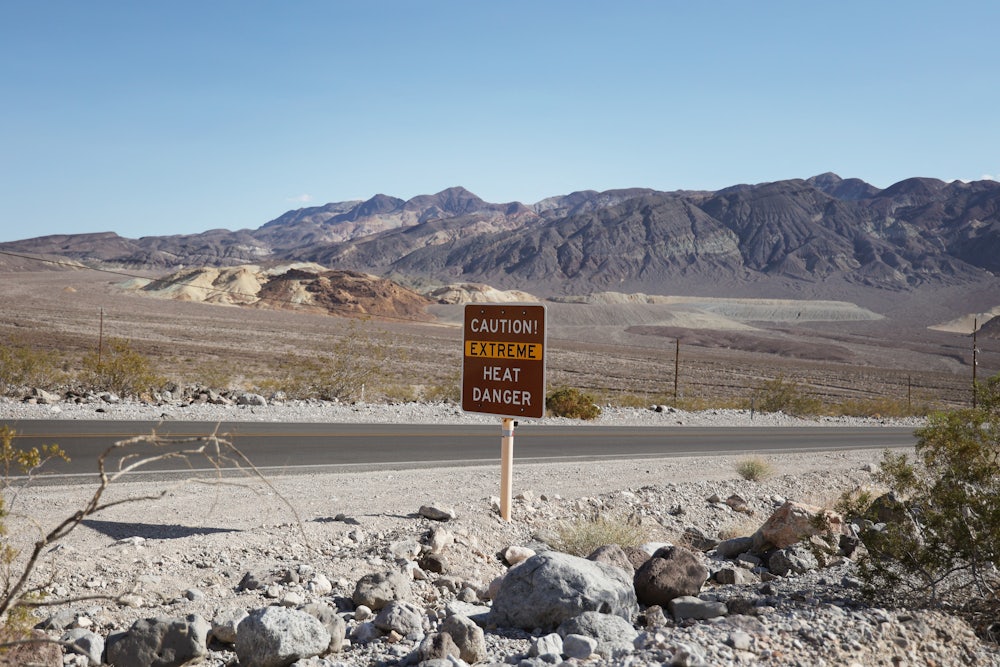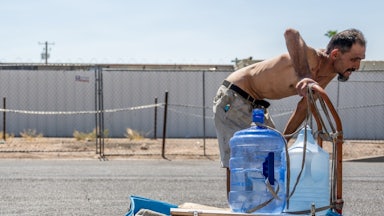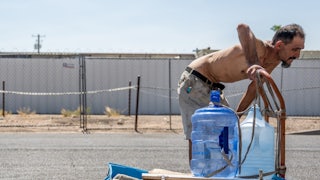By now, we’ve all heard the stories of tragic heat accidents and deaths. The hiker couple, their 1-year-old baby, and their dog—all dead of heatstroke on a familiar trail made alien by the rising mercury. The British King’s Guardsman tumbling to the ground with his trombone, a historic costume made unbearable in the heat (he lived). The 71-year-old hiker in Death Valley National Park, who told a reporter from the Los Angeles Times he was not deterred by the temperature just hours before dying on the trail.
These attention-grabbing stories represent a real and widespread threat. Heat waves across Europe killed 61,000 in the summer of 2022. In the United States, average annual heat-related deaths have risen 95 percent between 2010 and 2022, according to the Centers for Disease Control and Prevention. It’s only getting worse: Some experts are already predicting that this year could have record numbers of excess deaths due to the heat. By the end of the century, at this rate, a third or more of the world will not merely experience extreme heat but live in it.
The consequences of extreme heat are well understood: The body starts to sweat. Dehydration sets in. The blood thickens. The heart works harder to keep itself pumping, and so do the other organs, until the whole system is too stressed to continue. So-called “hyperthermia” can kill in just a few hours. Yet policy and public risk perception lag behind the research on extreme heat. The reasons are myriad: outdated mental models, few or unsatisfactory alternatives, and communication challenges. But to save lives, we must address each of these gaps in understanding and opportunity—ideally, all at once.
Public health officials, researchers, and reporters have warned for years that the greenhouse effect would kill—and kill viciously. Right now, the world is on track for 2.5 degrees Celsius (4.5 degrees Fahrenheit) of warming by the end of this century. The earth is already the hottest it’s been in at least 125,000 years. No one is prepared—and the ways we think about heat are making us even less ready.
The first problem? Heat is invisible. “It doesn’t bend tree branches or blow hair across your face to let you know it’s arrived,” journalist Jeff Goodell writes in his new book, The Heat Will Kill You First. But when it’s overhead, “the sun feels like the barrel of a gun pointed at you.” Instead of illuminating the issue, mass media often makes it worse. Too often, newspaper photography and morning news–show B-roll pair extreme heat stories with images of beach volleyball players and magnificent sunsets.
The second issue is that even if people are abstractly aware that heat kills, many individuals don’t know their own risk profile. In one 2019 study, researchers found that while residents of warm climates (like Nevada or Texas) associated heat and danger, people in overall cooler climates didn’t. But as this summer has shown, even in places like Alaska, people are still experiencing heat waves and the attendant risks. At the same time, the survey revealed that many older Americans, who are among the most vulnerable, underestimated the threat extreme heat poses to them specifically.
The third problem is a quirk of the human brain itself. Like a climate model, we each use past experiences to model future behavior. Some ways that our warming world is shifting will be gradual. But climate change is altering temperatures in some places at a rapid clip. It takes time for humans to acknowledge these developments; by then, the situation will have shifted once again. What chance does one human mind have when even formal, scientific weather models are struggling to keep up?
Summers used to be easier to endure. But heat in the twenty-first century has already changed in so many ways. Now these surges may be hotter than in the past, they may last longer, there may be multiple successive waves in a season, and the season itself may start earlier and end later. “Relying on your past experiences may not apply,” Zachary Schlader, a behavioral thermoregulation expert at Indiana University, told me.
Many climates are also becoming more humid, as warmer air can hold more water. To cool the surface temperature of the skin, humans rely on sweat. But when sweat can’t evaporate, as is the case in high humidity conditions, it ceases to be an effective cooling mechanism. Humans can endure a wet bulb temperature—a measurement of temperature and humidity combined—of just 95 degrees. Past this threshold, even shade, sleep, and water won’t be enough to stave off death. In recent years, places in the Middle East—where residents are already accustomed to some of the highest temperatures on earth—have passed this line for the first time. No amount of mental or cultural acclimation can save you when you need to go outside and find it’s too hot to survive.
Misperceptions about heat add up. Take hiking: It’s becoming more difficult to figure out how to safely access the great outdoors. “You’re forecasting in your mind what you’re going to experience and being prepared for that,” Schlader said. You bring a little extra water. “But you didn’t really know how much water [you needed],” he said. You’re conscious of your pace—but you don’t know how slow to really go in heat you’ve never experienced before. What looks like preparedness means little under the scorching sun. “Our body is amazing at thermoregulating,” Schlader said, “but at some point, our behavioral system needs to take over.”
And that brings us to the fourth challenge: If you miscalculate, there’s often little recourse. If hikers realize they’re overheating, and there is no extra water and no shade, they’ll feel the need to get back to their air-conditioned car at any cost. “There’s some competing motivation: ‘Hey, I gotta get out of here, I’m going to push myself through that,’” Schlader said. And this applies not only to national parks but to the homes and streets of well-populated cities. If people can’t afford their air conditioning bill, they’ll wait to turn it on. If their only cooling center is miles away, they may just wait it out in their stuffy apartment. If bus stops don’t provide shade, they may suffer heat exhaustion on the way to work.
Scholars like Schalder are calling for more research on how people respond to extreme heat. With more data, they hope, they’ll be able to target even better interventions. Already we know that education and public health communication will be essential to help people understand their individual risks and how to manage them. Older adults, young children, people with certain preexisting conditions, and people of lower socioeconomic status (who may live in shade deserts, work outdoors, or face other obstacles to cooling) must be a priority in the response.
Working up from the individual level, programs to supply people with air conditioners and alleviate the burden of their electricity bills can help. So can smaller-scale solutions, like providing people with abundant shade (natural or artificial), water to drink, water to spray on their skin, and electric fans, wherever they go. Workplace regulations are also urgently needed, not only to ensure outdoor workers have regularly scheduled reprieves from the heat but that they have the autonomy to honor their body’s unique experience of heat and take breaks as they need. In these conditions, pushing through is increasingly not an option.
At the same time as we work on reducing the harms of extreme heat, we must also seek to decarbonize, to prevent future warming. Jim Hansen, the climate scientist, recently wrote that the world is “headed into new climate territory, not seen in the past million years.” Much of this warming is already locked in—the long tail of earlier generations’ carbon emissions. But there is still reason to hope. Every degree of warming counts and, with concentrated effort and bold political action, we can still work to secure a habitable future.
This summer has proven that we are in an evolutionary battle of sorts. Modern Homo sapiens evolved 200,000 years ago in a period of natural climate change. Some researchers hypothesize that heat may have motivated our ancestors to stand upright and lose their fur. Now we’re forcing a new and uncharted adaptation upon ourselves—the direct consequence of our own greenhouse gas emissions. The only question is, can we adapt fast enough to survive it—and do the work to ensure it doesn’t get worse?










